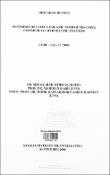Options
Synthesis Of Useful Organic Compounds Using Commercial Hydrolytic Enzymes
Date Issued
2006
Author(s)
Abstract
Enzyme catalysis is most attractive for the synthesis and modification of biologically relevant classes of organic compounds which are difficult to prepare and to handle by conventional means. In this study, commercial hydrolytic enzymes were used in the preparation of two novel organic compounds with excellent properties and application as fragrance and flavour - isoamyl acetate, a substance with peculiar banana fragrance and (-)-menthy1 butyrate, a substance with cooling and refreshing minty effects. In the synthesis of isoamyl acetate, reaction consisting of acetic anhydride and isoamyl alcohol were catalysed using lipase from Rhizomucor miehei (Lipozyme IM- 20), based on the method by Krishna et al., (2001). Yields above 93 % were achieved with substrate concentration as high as 1.5 M and more than 150 g/L isoamyl acetate concentrations were obtained employing relatively low enzyme concentration of 10 g/L after 100 hours of incubation. The product was then subjected to characterization using Fourier-transform infra-red (FT-IR) spectrophotometer, gas chromatographymass spectrometer (GC-MS) and nucleus magnetic resonance (NMR) to ensure purity. Biological activity assay of the compound was done for their cytotoxic effect against HL60 (human promyelocytic leukemia) and breast cancer (MCF7) cell lines. In the actimicrobial activity assay, microbes tested were MRSA (MethiciNin resistant S~aphylococcus aureus), Bacillus substilis and Pseudomonas aeruginosa. Isoamyl acetate was found biologically inactive towards targeted microbes and both cancer cell lines. In this synthesis of (-)-menthy1 butyrate, among seven lipases tested, Candida rzrgosa lipase exhibited the best ability to catalyze the resolution of (*)-menthol in organic solvent. To ensure purity of the compound, it was characterized using Fouriertransform infra-red (FT-IR) spectrophotometer, gas chromatography (GC), thin layer chromatography (TLC) and gas chromatography-mass spectrometer (GC-MS).
File(s)
Loading...
Name
Synthesis of useful Organic Compounds abstrak.pdf
Size
13.78 MB
Format
Adobe PDF
Checksum
(MD5):afbdaeada1c71db12f833fb4941296ed